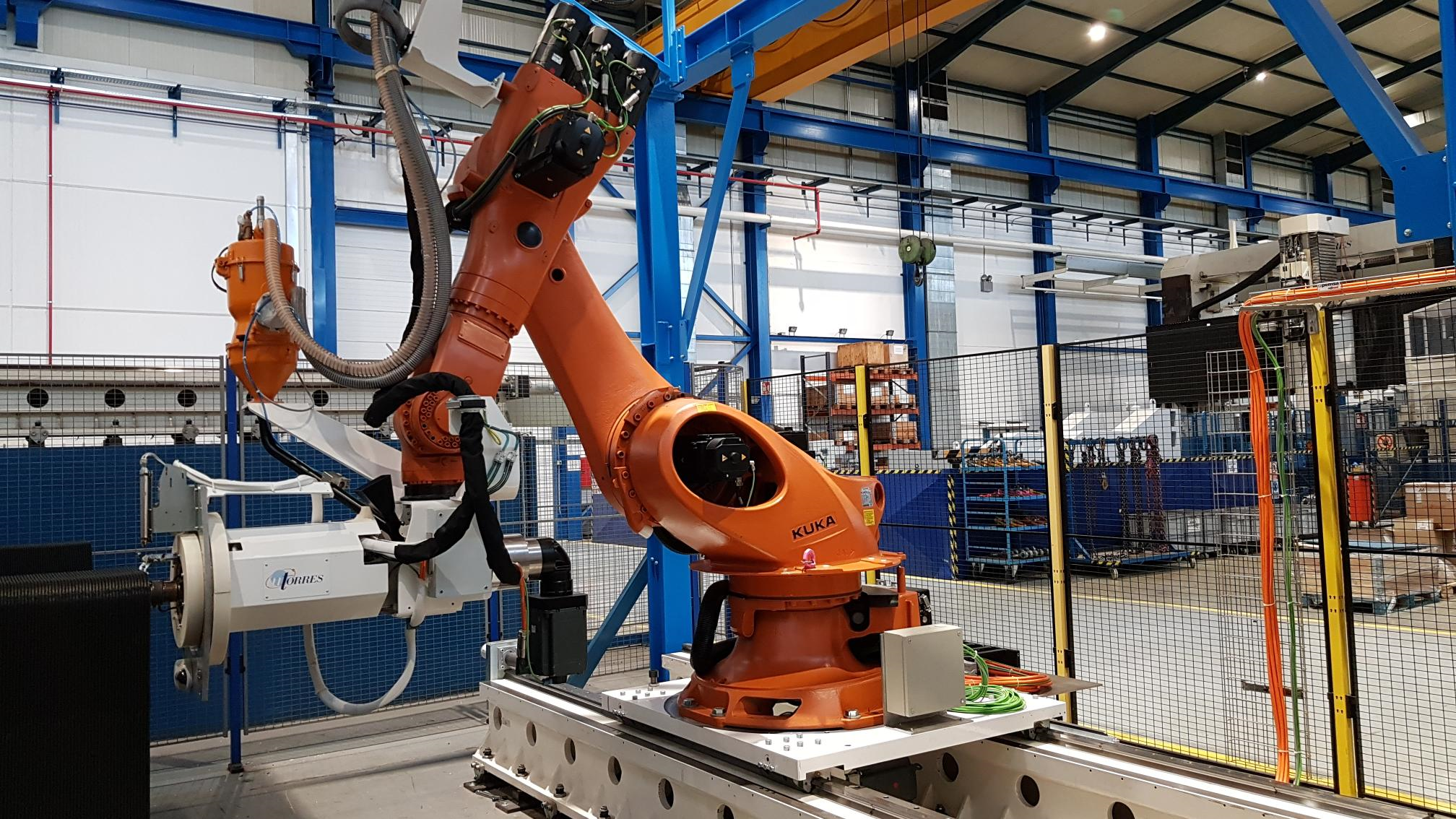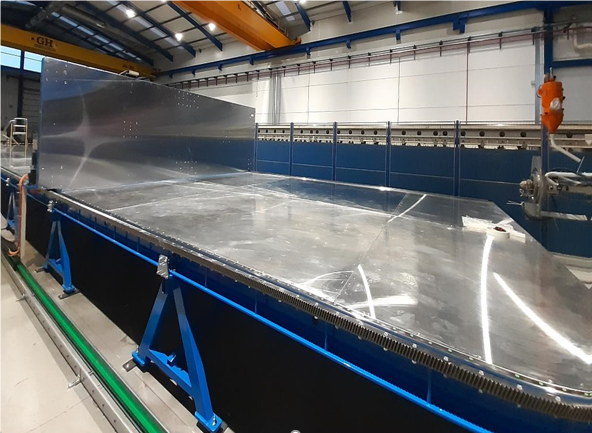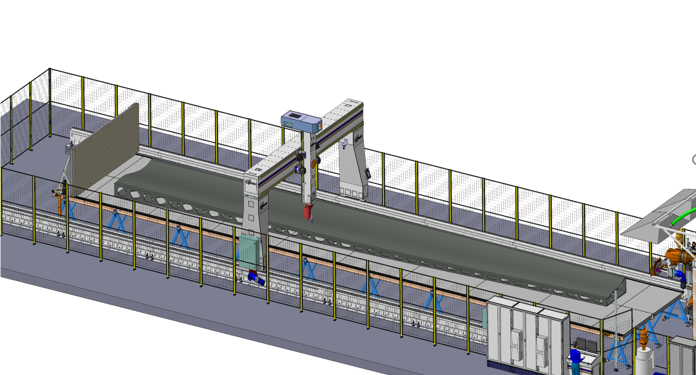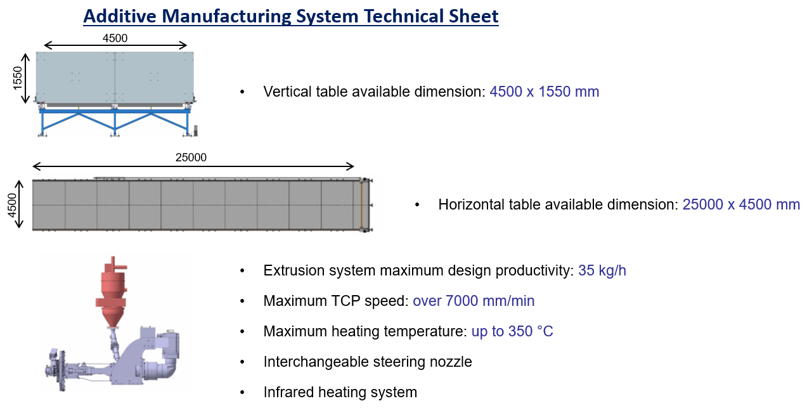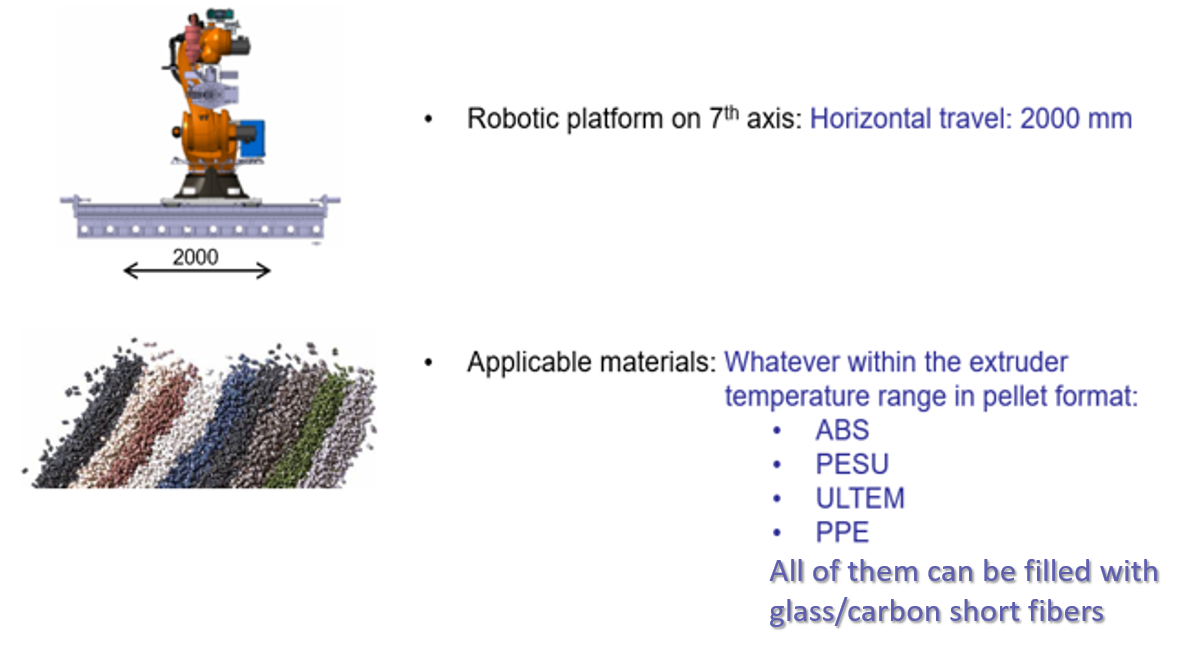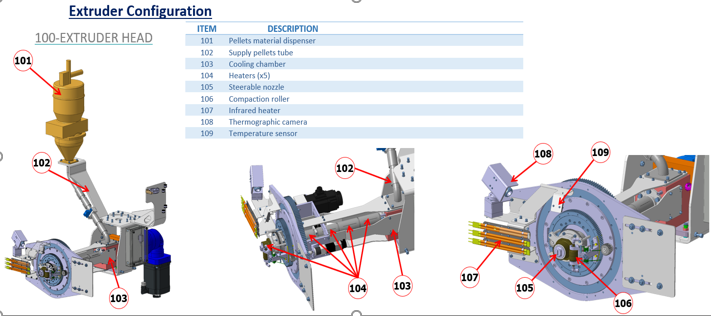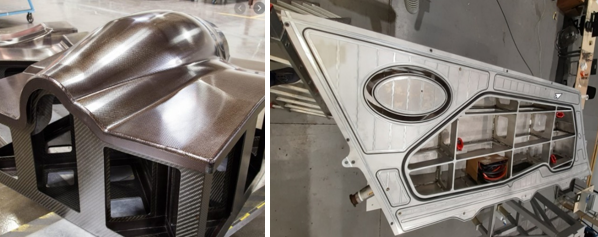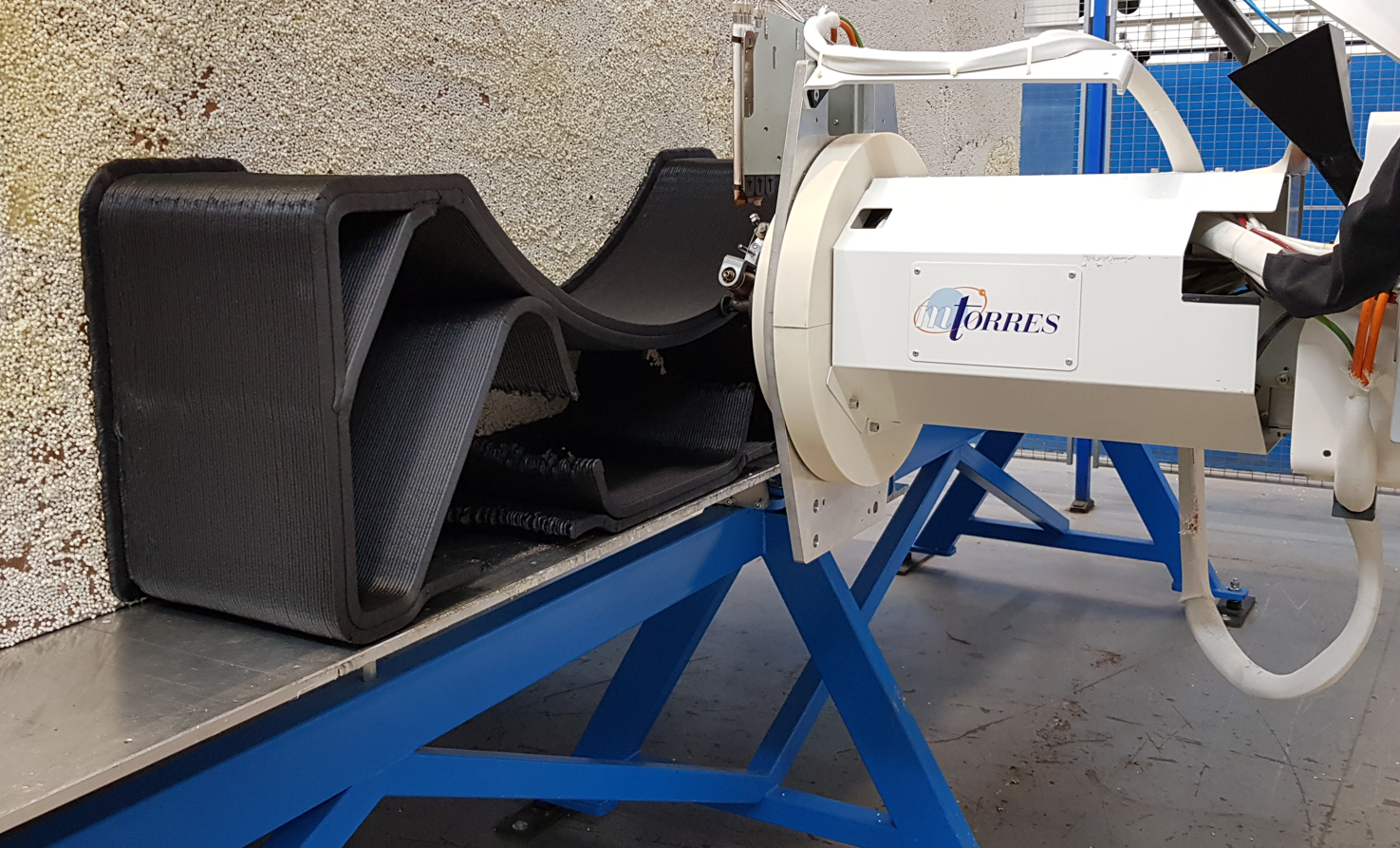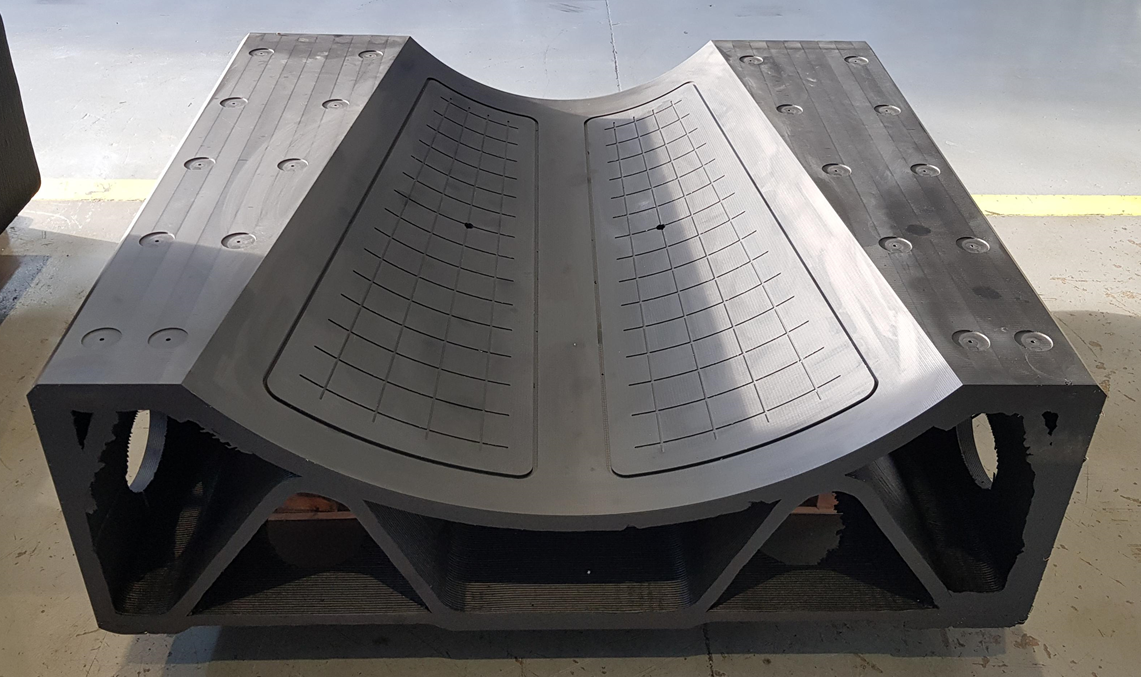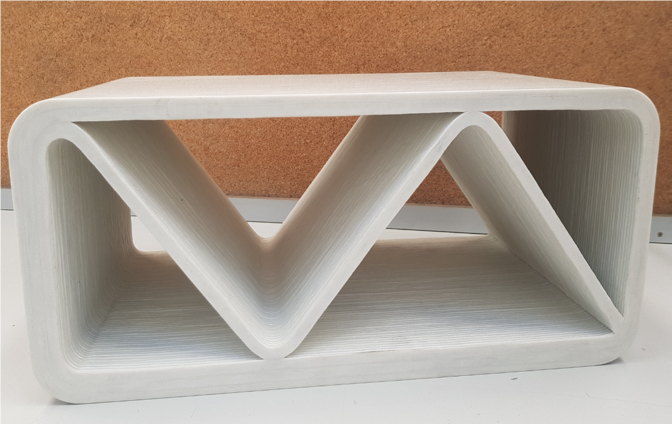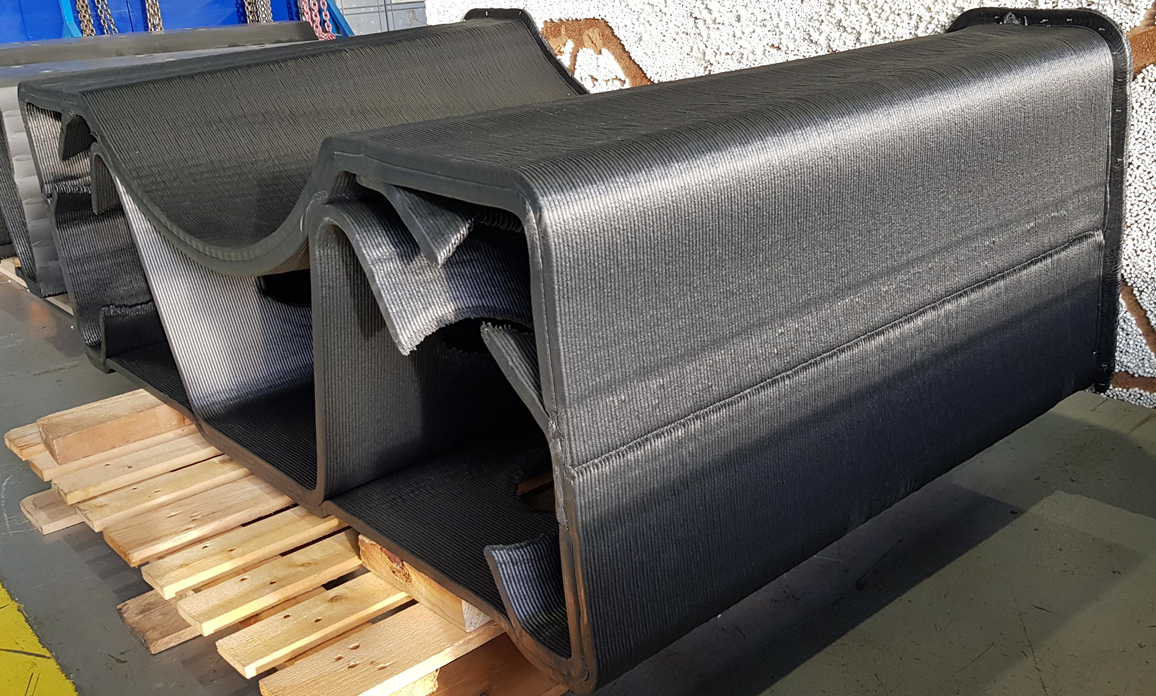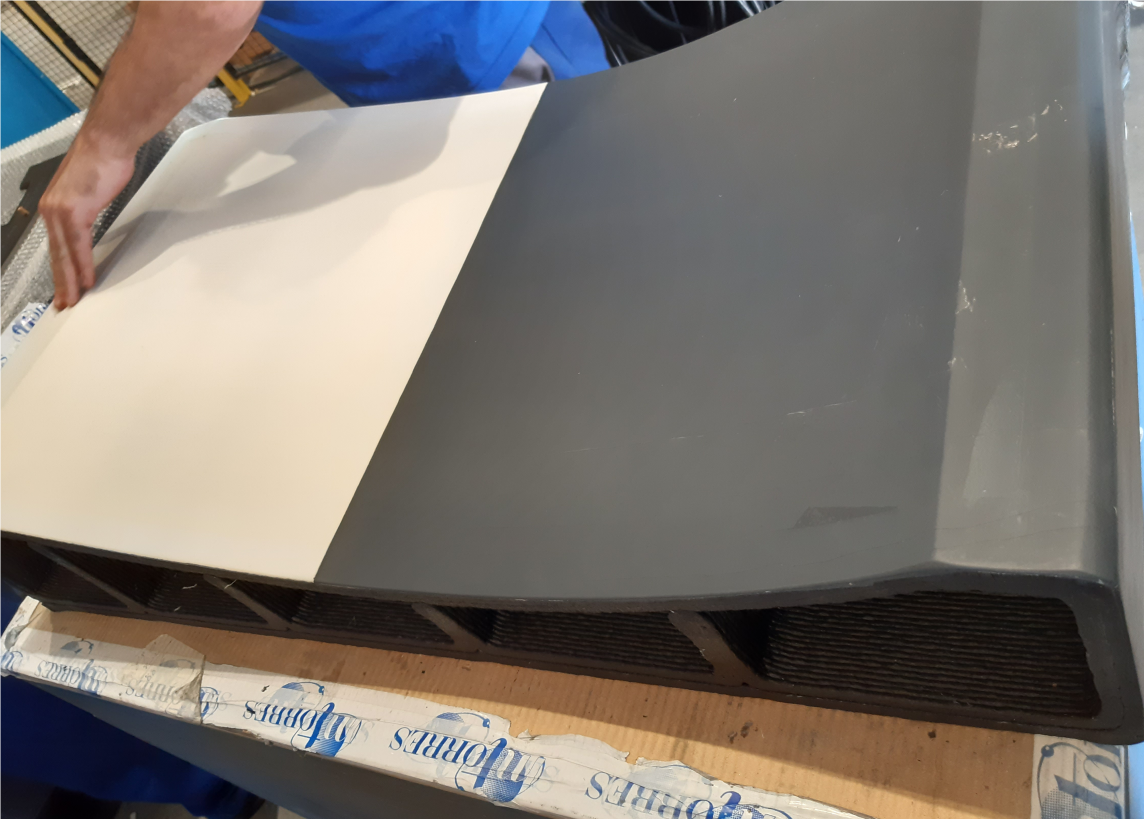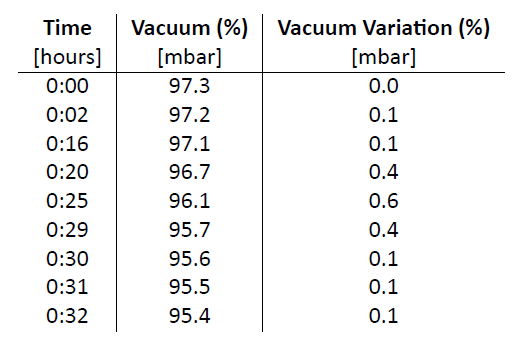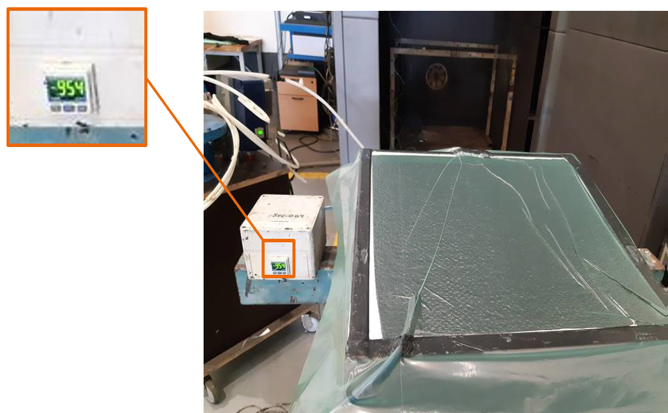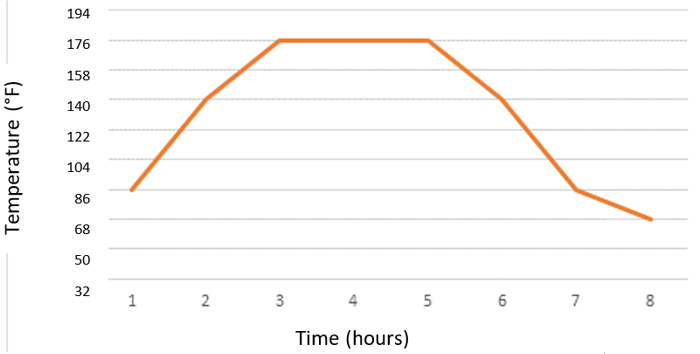1. Introduction
Additive manufacturing (AM), also known as 3D printing, has opened new possibilities to manufacture parts for the general industry. Initially oriented to small-scale, prototype-like components, recent advancements and developments allow using this technology to produce more complex pieces for daily applications [7].
The big area additive manufacturing (BAAM) [3] aims to use additive manufacturing process in the manufacturing of large-scale components that would otherwise have a manufacturing need much more complex and expensive. Although continuous improvement is being made [8, 1], the structural performance of the parts produced with AM presents a limitation and narrows its application as structural parts. Despite these limitations, there are many applications [4] where the structural requirements of the parts are lower or components where AM parts are combined with reinforced fiber polymers to achieve the final required performance.
Current BAAM technologies usually focus on implementing an additive manufacturing head on a moving system such as a gantry structure, a robotic platform, or other. These systems place one layer of material on top of another following the predefined trajectories needed to produce the final desired geometry of the parts. One of the limitations of this process is the requirement to heat the material. Usually, the material applied through the nozzle and the previous layer must be heated to achieve good bonding between layers. The industry has developed several alternatives to obtain the required process temperatures in the previously deposited layers. One of the proposed solutions is to maintain the parts being manufactured in a tempered room. Other alternatives are also being developed [2].
The generation of large parts is limited by the displacement of the moving system holding the additive manufacturing head and the dimensions of the tempered zone. These restrictions impose limitations on the size of parts produce using BAAM, requiring, at the same time, significant initial investments. This article analyzes and presents the results obtained manufacturing large parts using an equipment developed by MTorres (TorresPrint3D®) with a configuration where the part heating system is incorporated into the extrusion head. The part size limitations are removed by employing a moving table that supports the part during the fabrication.
2. Description of the developed solution, TorresPrint3D®
Since 2020, a new concept capable of producing large parts using additive manufacturing has been in development by MTorres. The research focused on designing an extrusion head capable of achieving high productivity rates, laying down up to 50 Kg/hour (110lb/hour), and heating the material up to 350°C (662°F) allowing the use of diverse types of materials. The final configuration of the AM system is composed of a horizontal axis extrusion head placed on a robotic platform. The robotic platform has an additional axis along the transversal direction (Fig. 1) that increases the size of the produced parts in the horizontal transversal direction(Y-axis).
Figure 1: TorresPrint3D® Robotic Platform with extra horizontal axis (Y-Axis)
With this equipment configuration, the extrusion head places the melted material in the vertical plane that moves along the length of the working table (Fig. 2). The table provides support for the part, allowing manufacturing parts up to 25 meters in length (82 ft.). The AM system performs the fabrication by placing layers of the material in the vertical plane. Once the material layer is completed, the table moves a distance equivalent to the thickness of the layer, what is called a pulse, allowing the extrusion head to lay up the next material layer on top of the previous one.
Figure 2: Horizontal table used to produce large parts
The proposed system configuration would allow manufacturing parts by placing the material in other orientations. This flexibility would make installing the extrusion head in a Cartesian system or on a gantry-type system possible, making it possible to work with the extruder axis located on horizontal or vertical position. The AM system can be combined with high-speed milling equipment installed in the same cell (Fig. 3), which would mill the part while it is on top of the horizontal table to its final dimensions.
Figure 3: TorresPrint3D® cell including the high-speed milling equipment
And it is also possible to have a multi-functional machine, with a robot, gantry or whatever other kinematic configuration supporting alternatively a milling or additive manufacturing end effector, with automatic end effector exchange between them.
The developed cell can produce parts up to 4.5 meters in width (14.75 ft.), 1.55 meters in height (5 ft.), and a length of up to 25 meters (82 ft.). The overall dimensions and specifications of the extrusion head are summarized in Figures 4 and 5.
Figure 4: Summary of the specifications of the TorresPrint3D® manufacturing system
Figure 5: Summary of the specifications of the TorresPrint3D® manufacturing system
The main components of the TorresPrint3D® extrusion system (Fig. 6) are the extrusion head (complete additive manufacturing end effector), the material feeder, the local heating system, and the extrusion nozzle.
The extrusion nozzle has several relevant subcomponents:
• A layer-thickness control system that combines the material feeding rate with the extrusion head speed to produce the desired bead width.
• A compacting-system with a coaxial rotation with respect to the extrusion nozzle. A trajectory calculation software is used to determine the optimal trajectory of the compacting system.
• An IR-heating system (it would be possible to install another heating system as a hot air blast). The heating system rotates concentrically to the extrusion nozzle and uses the same control software than the compaction system.
Figure 6: Extrusion Head Subcomponents
One of the main goals of the new development was to design an AM system that would not require control of the environmental conditions using heated rooms, which is one of the main limitations of the existing equipment to produce large parts.
Another essential part of the TorresPrint3D® system is integrating the part program software with the equipment control. The proposed integral solution uses native CAD models and manufacturing inputs to determine the optimal production trajectories. The software generates the part-program, which includes the setups and configuration files for all the integrated auxiliary systems.
The post-processor system also includes a real-time 3D tool that simulates the generated part program, providing information on the working parameters for all axis. The simulation software is used to validate the generated programs and verify that no collisions and out-of-limit motions are commanded.
The proposed solution was engineered, focusing on the manufacturing of large molds. The traditional way of manufacturing these large parts is costly and requires a long manufacturing process that can last several months. Choosing carefully the materials used in the AM process, it would be possible to use AM to produce molds capable of withstanding the high temperatures used in the autoclave. The TorresPrint3D® system also allows manufacturing parts and tools with complex geometries (Fig.7).
Figure 7: Example of tools and molds that can be manufactured using the proposed AM system
3. Experimental Results
During the initial TorresPrint3D® system testing, Mtorres focused its efforts on finding the optimal parameters of the process. The parameters that most influenced the quality of the final part are the temperature of the material that is fed through the nozzle ([Figure 8). This temperature is critical to obtain good adhesion between the layer being placed and the previous one. Incorrect temperatures lead to the typical warping and cracking defects of AM processes. Mtorres developed algorithms that used process parameters as temperature sensors located on the extrusion nozzle, lay-up speed, and extrusion head rotation speed, among others, to control accurately the heating ramp of the material being extruded.
Figure 8: AM head placing material in the vertical plane
Figure 9: Mold type part aspect after milling process
The materials used during the development and testing phase of the TorresPrint3D® system were:
· ZC004 from Sabic (SABIC - LNPTM STAT-KONTM Compound)
· PESU 1810 3DP de Electrafil
· ABS+glass fiber (Fig. 10)
· AC004XXAR1 from Sabic (LNP™ THERMOCOMP™ AM, ABS + CF) (Fig.11)
Figure 10: Example of a part made of ABS+GF after milling and polishing
Figure 11: Example of a part made of ABS+CF
After completing the part’s manufacture using the TorresPrint3D® head, pieces are milled and primed (Fig. 9 and 12). Considering that some produced part will be used as a curing mold, MTorres tested some pieces under thermal cycling. Vacuum leaking (Fig.13) and dimensional stability after each thermal cycle were measured. The results obtained were according to what was expected. One of the main goals of this test was to produce a part that does not require repairs after entering into production due to vacuum leaks or dimensional variations.
Figure 12: Example of mold after milling and priming
Typical results obtained during the vacuum tests (Table 1 contains an example of the results for a leak test) are:
• Maximum vacuum level reached: 97.3%
• Vacuum level after 30 min. after having disconnected the vacuum pump: 95.4%
Table 1: Vacuum levels during the tests
Figure 13: Leaking tests configuration
More than sixty complete thermal cycles without dimensional variations or vacuum leaking issues were performed. During the tests, MTorres used a standard thermal cycle employed for the curing of composite materials (Fig. 14).
Figure 14: Temperature cycle used during dimensional stability tests
The results obtained after sixty thermal cycles showed good dimensional stability, without appreciable deviations, the appearance of cracks, or other defects on the surfaces. Flaws in the mold’s coating were not observed, confirming that one of the main applications of this technology will be the production of molds used to manufacture short series of autoclave cured composite parts.
From the point of view of manufacturing lead times, TorresPrint3D® can produce large parts requiring substantially less time. As a reference, making a 25m long metallic component using the traditional manufacturing method can take up to 12 weeks. The proposed cell can build a similar in less than 20 days.
4. Conclusions
As a result of the development phase, MTorres has produced an innovative additive manufacturing system focused on manufacturing large components using an equipment configuration designed to make these large parts without controlling the external environmental conditions. The proposed system integrates the subsystems required to precondition the materials and the in-process part. The extrusion head was installed on a robotic platform that included an extra y-axis, allowing the manufacturing of large parts. The proposed system is versatile enough to install it on other types of movement configurations, like Cartesian or gantry-type machines.
One of the critical features of the proposed solution is the integration of the part-program development within the control of the machine, simplifying the determination of the optimal trajectories and working parameters. The other essential part of the innovation was the development of specific materials adapted to the necessities of the AM process. The results obtained have demonstrated an extraordinary behavior of the parts produced, with excellent thermal stability and mechanical strength, which validated the TorresPrint3D® technology for the manufacturing of tools with complex geometries, curing molds for short series. The investigation results also confirmed that this manufacturing process is capable of reducing the manufacturing costs and the manufacturing time considerably.
References
[1] Osama Abdulhameed et al. “Additive manufacturing: Challenges, trends, and applications.” In: Advances in Mechanical Engineering 11(2) (2019), pp. 1- -27. DOI: DOI:10.1177/1687814018822880.
[2] Vidya Kishore et al. “Infrared preheating to improve interlayer strength of big area additive manufacturing (BAAM) components.” In: Additive Manufacturing 14 (2017), pp. 7- -12. DOI: https://doi.org/10.1016/j.addma.2016.11.008.
[3] Lonnie J. Love and Chad Duty. “Cincinnate Big Area Additive Manufacturing (BAAM).” In: CRADA Final Report NFE-14-04967 (2015).
[4] Pedram Parandoush and Dong Lin. “A review on additive manufacturing of polymer-fiber composites.” In: Composite Structures 182 (2017), pp. 36- -53. DOI: https://doi.org/10.1016/j.compstruct.2017.08.088.
[5] Brian K. Post et al. “Big Area Additive manufacturing application in wind turbine molds.” In: Proceedings of the 28th Annual International Solid Freeeform Fabrication Symposium ().
[6] Brian Post et al. “Feasibility of using Big Area Additive Manufacturing to Directly Manufacture Boat Molds.” In: Final Report NN-17-1062 (2018).
[7] Panagiotis Stavropoulos et al. “Addressing the challenges for the industrial application of additive manufacturing: Towards a hybrid solution.” In: International Journal of Lightweight Materials and Manufacture 1.2 (2018), pp. 157- -168. DOI: https://doi.org/10.1016/j.ijlmm.2018.07.002.
[8] Syed A.M. Tofail et al. “Additive manufacturing: scientific and technological challenges, market uptake and opportunities.” In: Materials Today 21.1 (2018), pp. 22- -37. DOI: https://doi.org/10.1016/j.mattod.2017.07.001.
Document information
Published on 18/07/22
Accepted on 20/06/22
Submitted on 29/04/22
Volume 07 - COMUNICACIONES MATCOMP21 (2022), Issue Núm. 1 - Sostenibilidad y reciclaje - Fabricación, 2022
DOI: 10.23967/r.matcomp.2022.07.048
Licence: Other
Share this document
Keywords
claim authorship
Are you one of the authors of this document?
